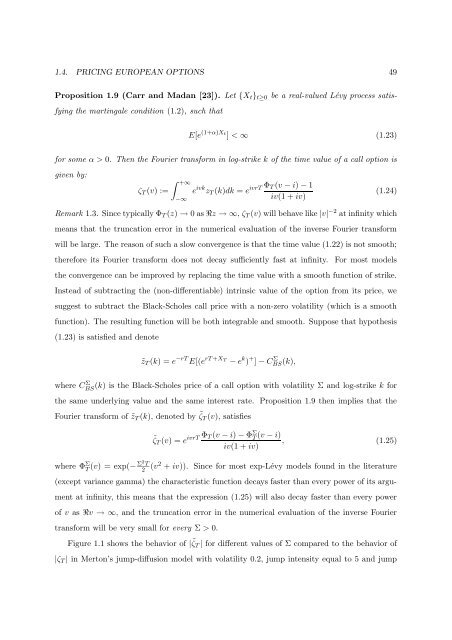Processus de Lévy en Finance - Laboratoire de Probabilités et ...
Processus de Lévy en Finance - Laboratoire de Probabilités et ...
Processus de Lévy en Finance - Laboratoire de Probabilités et ...
Create successful ePaper yourself
Turn your PDF publications into a flip-book with our unique Google optimized e-Paper software.
1.4. PRICING EUROPEAN OPTIONS 49<br />
Proposition 1.9 (Carr and Madan [23]). L<strong>et</strong> {X t } t≥0 be a real-valued Lévy process satisfying<br />
the martingale condition (1.2), such that<br />
E[e (1+α)Xt ] < ∞ (1.23)<br />
for some α > 0. Th<strong>en</strong> the Fourier transform in log-strike k of the time value of a call option is<br />
giv<strong>en</strong> by:<br />
ζ T (v) :=<br />
∫ +∞<br />
−∞<br />
e ivk z T (k)dk = e ivrT Φ T (v − i) − 1<br />
iv(1 + iv)<br />
(1.24)<br />
Remark 1.3. Since typically Φ T (z) → 0 as Rz → ∞, ζ T (v) will behave like |v| −2 at infinity which<br />
means that the truncation error in the numerical evaluation of the inverse Fourier transform<br />
will be large. The reason of such a slow converg<strong>en</strong>ce is that the time value (1.22) is not smooth;<br />
therefore its Fourier transform does not <strong>de</strong>cay suffici<strong>en</strong>tly fast at infinity. For most mo<strong>de</strong>ls<br />
the converg<strong>en</strong>ce can be improved by replacing the time value with a smooth function of strike.<br />
Instead of subtracting the (non-differ<strong>en</strong>tiable) intrinsic value of the option from its price, we<br />
suggest to subtract the Black-Scholes call price with a non-zero volatility (which is a smooth<br />
function). The resulting function will be both integrable and smooth. Suppose that hypothesis<br />
(1.23) is satisfied and <strong>de</strong>note<br />
˜z T (k) = e −rT E[(e rT +X T<br />
− e k ) + ] − C Σ BS(k),<br />
where CBS Σ (k) is the Black-Scholes price of a call option with volatility Σ and log-strike k for<br />
the same un<strong>de</strong>rlying value and the same interest rate. Proposition 1.9 th<strong>en</strong> implies that the<br />
Fourier transform of ˜z T (k), <strong>de</strong>noted by ˜ζ T (v), satisfies<br />
˜ζ T (v) = e ivrT Φ T (v − i) − Φ Σ T<br />
(v − i)<br />
, (1.25)<br />
iv(1 + iv)<br />
where Φ Σ T (v) = exp(− Σ2 T<br />
2 (v2 + iv)). Since for most exp-Lévy mo<strong>de</strong>ls found in the literature<br />
(except variance gamma) the characteristic function <strong>de</strong>cays faster than every power of its argum<strong>en</strong>t<br />
at infinity, this means that the expression (1.25) will also <strong>de</strong>cay faster than every power<br />
of v as Rv → ∞, and the truncation error in the numerical evaluation of the inverse Fourier<br />
transform will be very small for every Σ > 0.<br />
Figure 1.1 shows the behavior of |˜ζ T | for differ<strong>en</strong>t values of Σ compared to the behavior of<br />
|ζ T | in Merton’s jump-diffusion mo<strong>de</strong>l with volatility 0.2, jump int<strong>en</strong>sity equal to 5 and jump
















